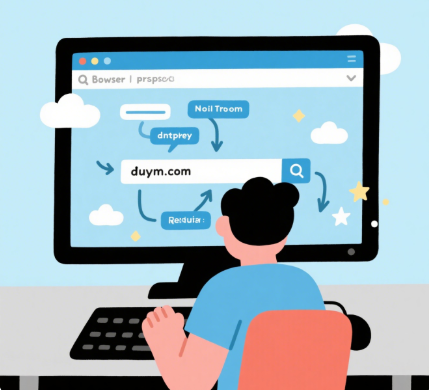Domain name anti-red means using systematic technical means to prevent domain names from being marked as unsafe, blocked by the platform or blacklisted, to ensure business continuity and access security. The specific implementation requires comprehensive technical deployment, protocol configuration and continuous monitoring. The following will share the core methods and practical strategies.
Dynamic protection mechanism can be adopted at the technical layer
The domain name rotation system and automated tools can be used to detect the domain name status in real time, and once the ban rule is triggered, it will immediately switch to the backup domain name. In the early days, it will rely on basic jumps such as HTTP302 redirection, but now it is necessary to combine AI behavior analysis to identify platform detection patterns. Dynamically adjust the jump frequency and path to avoid being identified as abnormal traffic by the rule engine. For example, e-commerce promotion links can be configured with 510 backup domain names. When the primary domain name fails to access and exceeds the threshold, it will automatically switch to reduce the risk of single point failure.
Localized client deployment
Integrate the anti-red function into an independent client or SDK, and the local service will take over the jump logic when the user accesses the link. For example, when the browser hijacks the jump, when clicking a link on a certain platform, the local interface is called to force the jump to the system default browser to open the page, avoiding the review mechanism within the platform. The reporting function is blocked. The reporting button in the upper right corner of the platform is disabled through the front-end script, and the page code structure is obfuscated to interfere with robot crawler detection, extending the domain name survival cycle. This solution is suitable for highly sensitive scenarios such as H5 games and novel platforms.
Live code anti-blocking system
Use a one-time or short-term valid domain name (such as 24-hour expiration) and dynamically generate a new link in combination with the back-end API. Every time a user visits, the system assigns a new domain name and destroys the old link to achieve the recycling of the "domain name pool". Although the cost is high (domain names need to be purchased continuously), it can cope with strict review environments.
Basic layer: protocol and security reinforcement
DNSSEC deployment, the core measure to resist DNS hijacking. Verify the integrity of DNS response data through digital signatures to prevent the resolution results from being tampered with. The implementation steps include: enabling DNSSEC support at the domain name registrar; using the dnssecsignzone tool to sign the zone file; configuring the authoritative DNS server to enable verification (such as setting dnssecenable yes in the BIND configuration). HTTPS mandatory encryption and certificate management
Enable HTTPS for the entire site. Configure Nginx or Apache to force HTTP requests to jump to HTTPS, and deploy HSTS headers (StrictTransportSecurity) to prevent SSL stripping attacks. Automatically update certificates, apply for Let's Encrypt certificates through the Certbot tool, and set up cron tasks for regular renewal to avoid browser alerts due to certificate expiration.

Real-time monitoring of blacklists
Access third-party security services and scan domain names daily to see if they are included in the malicious database. If a ban is found, immediately execute: check server vulnerabilities (such as SQL injection, malicious file upload); clean up illegal content and submit a review application; enable backup domain names to divert traffic.
Architecture layer: distributed and anti-attack design
Multi-node DNS resolution. Deploy at least 3 authoritative DNS servers in different geographical regions (such as North America, Europe, and Asia), and use Anycast routing technology to direct queries to the optimal node. When a single node is attacked by DDoS, traffic is automatically transferred to healthy nodes to ensure resolution availability.
Third-party high-defense DNS entrustment. Choose a service provider with Tbps-level cleaning capabilities. Its advantages include elastic bandwidth to resist flooding attacks; integrated threat intelligence library to intercept malicious IP; and provision of enhanced protocols such as DNSSEC and DoH (DNS over HTTPS). The downtime rate of self-built DNS is about 9.87%, while professional hosting services can be reduced to less than 2%.
DDoS protection and traffic cleaning
Deploy a cleaning center at the entrance of the backbone network, and guide the attack traffic to the cleaning device through BGP traction. Filtering strategies include: SYN Cookie verification of forged source IP connection; AI-based behavioral analysis to identify CC attack patterns; application layer rules to filter HTTP Flood (such as intercepting unconventional UserAgent requests).
Management: Compliance and response mechanism
Content compliance audit deploys AI content scanning tools: real-time detection of sensitive keywords (such as political, violent and terrorist words), abnormal images (OCR recognition) and illegal external links; manual review mechanism High-risk content (user-generated content/UGC) requires secondary review before it can be published.
WHOIS information maintenance and domain name locking. Ensure that the registered email and phone number are real and valid to avoid domain name hijacking due to invalid information; enable the "domain name lock" function provided by the registrar to prohibit unauthorized transfer operations. Quick appeal channel, establish a ban emergency response process to collect evidence, server logs, content rectification screenshots; contact the platform customer service to submit a work order; if it involves a mistaken ban, request expedited processing and unblocking within 24 hours.
Domain name red prevention requires the construction of a four-dimensional system of "dynamic jump protocol to strengthen distributed architecture compliance management". On the technical level, domain name rotation and localized jump solve the problem of instant ban; DNSSEC and HTTPS build a solid security baseline; multi-node DNS and high-defense hosting ensure infrastructure resilience; and continuous content review and rapid appeal avoid operational risks. As platform rules continue to upgrade, enterprises should combine behavioral analysis AI and real-time threat intelligence to achieve a transformation from passive defense to active risk prediction.

 EN
EN
 CN
CN









